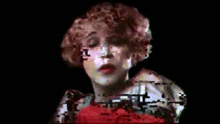| Revision as of 20:14, 6 August 2013 editBrandonbarber (talk | contribs)1 editm →External links← Previous edit | Revision as of 00:30, 7 August 2013 edit undoFreshacconci (talk | contribs)Extended confirmed users, Pending changes reviewers, Rollbackers49,746 edits Reverted 1 edit by Brandonbarber (talk): Spam. (TW)Next edit → | ||
| Line 50: | Line 50: | ||
| * Documentary produced by ] | * Documentary produced by ] | ||
| * | * | ||
| * | |||
| * | |||
| {{DEFAULTSORT:Glitch Art}} | {{DEFAULTSORT:Glitch Art}} | ||
Revision as of 00:30, 7 August 2013
Glitch art is the aestheticization of digital or analog errors, such as artifacts and other "bugs", by either corrupting digital code/data or by physically manipulating electronic devices (for example by circuit bending).
History of the term
In a technical sense a glitch is the unexpected result of a malfunction. It was first recorded in English in 1962 during the American space program by John Glenn when describing problems they were having, Glenn explained, "Literally, a glitch is a spike or change in voltage in an electrical current."
Early examples of glitches used in media art include Digital TV Dinner (1979) created by Raul Zaritsky, Jamie Fenton, and Dick Ainsworth by manipulating the Bally's video game console and recording the results on videotape.
Glitch is used to describe these kinds of bugs as they occur in software, video games, images, videos, audio, and other forms of data. The term glitch came to be associated with music in the mid 90s to describe a genre of experimental/noise/electronica (see glitch music). Shortly after, as VJs and other visual artist began to embrace the glitch as an aesthetic of the digital age, glitch art came to refer to a whole assembly of visual arts.
In January 2002, Motherboard, a tech-art collective held a glitch symposium in Oslo, Norway, to "bring together international artists, academics and other Glitch practitioners for a short space of time to share their work and ideas with the public and with each other."

On September 29 thru October 3, 2010, Chicago played host to the first GLI.TC/H, a five-day conference in Chicago organized by Nick Briz, Evan Meaney, Rosa Menkman and Jon Satrom that included workshops, lectures, performances, installations and screenings. In November 2011, the second GLI.TC/H event traveled from Chicago to Amsterdam and lastly to Birmingham, UK. It included workshops, screenings, lectures, performance, panel discussions and a gallery show over the course of seven days at the three cities.
Further reading
- Almond, Richard. "Fading Mnemonics and Digital Decay," 2009
- Baker-Smith, Ben. "Flickr Glitch Artists," 2010
- Bosma, Josephine. "Interview with Jodi," 1997
- Briz, Nick. Thoughts on Glitch(Art)v1.0, 2009
- Briz, Nick. Glitch & Art,' 2009
- Donaldson, Jeff. "gLossing over Thoughts on Glitch: A Poetry of Error." Artpulse Magazine Vol. 2, No. 3 (Spring 2011)
- Downey, Jonas. "Glitch Art." Ninthletter (2002). Retrieved February 23, 2013.
- Gaulon, Benjamin. DeFunct / ReFunct Publication, exhibition catalogue, 2011
- Geere, Duncan. "Glitch art created by 'databending'." Wired.co.uk (August 10, 2010). Retrieved July 15, 2011.
- Germen, Murat. "Inadvertent - Ars accidentalis." International Symposium on Computational Aesthetics in Graphics, Visualization, and Imaging (CAe 2008), Lisbon, Portugal.
- Goriunova, Olga and Alexei Shulgin. "Glitch," in Software Studies: A Lexicon, ed. Matthew Fuller (Cambridge, MA: MIT Press, 2008
- Grenzfurthner, Johannes. Interview with Phil Stearns. Pixel Form, 2010
- Krapp, Peter. Noise Channels: Glitch and Error in Digital Culture, Minneapolis: University of Minnesota Press 2011.
- Manon, Hugh S and Daniel Temkin, "Notes on Glitch," 2011
- Menkman, Rosa. The Glitch Moment(um), Network Notebooks 04, Institute of Network Cultures, Amsterdam. , 2011. ISBN 9789081602167
- Moradi, Iman. "Seeking Perfect Imperfection: A Personal Retrospective on Glitch Art. Vector (e-zine) 6 (July 2008). Retrieved July 15, 2011.
- Poremba, Cindy. "Point and Shoot: Remediating Photography in Gamespace." Games and Culture Volume 2, Number 1 (January 2007): 49-58.
See also
References
- Moradi, Iman. (2004) Glitch Aesthetic http://www.oculasm.org/glitch/download/Glitch_dissertation_print_with_pics.pdf
- Motherboard. (2002) http://www.liveart.org/motherboard/
- Rhizome. (2010) http://rhizome.org/editorial/2010/oct/13/code-eroded-at-glitch/#c63266
- the Creators Project. (2011) http://thecreatorsproject.com/blog/chicagos-glitch-fest-disrupts-the-traditional-gallery-space
- Cool Hunting (2011) http://www.coolhunting.com/culture/glitch.php
External links
- Glitch Art Documentary produced by Off Book (Web series)
- Glitch Theory wiki archive